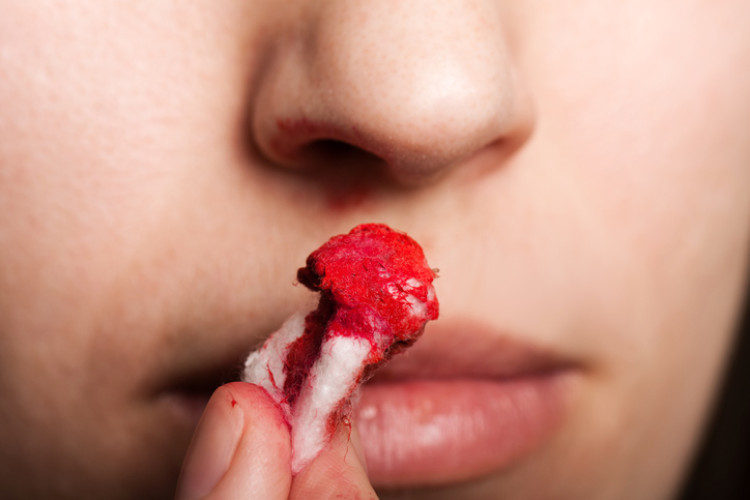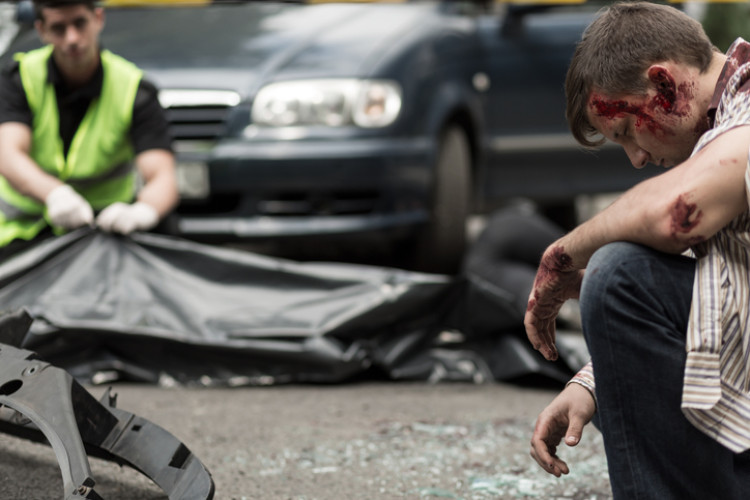Nosebleeds. What are the most common causes and how to stop it?

One of the most common bleeds that we are all familiar with is the epistaxis. It is mainly caused by a large blood supply in the front of the nasal septum at a place called the locus Kiesselbachi. However, it can occur on all the walls of the nasal cavity. Hairlines and veins bleed more often than arteries. Should we be worried about it? When does it become dangerous for us? What are the causes of its occurrence and how to stop it? The answers to these questions can be found in the article.
Article content
What are the basic causes of nosebleeds?
- Internal - The reason for this is the weakening of the vascular walls directly in the nasal mucosa or a general disease that secondarily provokes epistaxis. The latter occurs, for example, with allergic rhinitis, inflammation of the mucous membranes of the nose and sinuses, bleeding polyps of the nasal septum, tumors, scarlet fever, influenza, general atherosclerosis of blood vessels, their rupture on the basis of high blood pressure, after surgical procedures, due to physical damage after a blow to the nose or other trauma with a direct impact on the nose or even indirect with subsequent nosebleeds.
- External - The cause is due to changes in atmospheric (barometric) pressure which strain the blood vessels. People whose occupations or hobbies cause these changes repeatedly are at risk. For example, divers, where the atmospheric pressure rises by one atmosphere for every 10 m drop. Conversely, people at high altitudes (climbers, aircraft pilots), where the atmospheric pressure drops by 1 hPa for every 10 m ascent.
The main mechanisms of formation
There are many causes. However, the mechanisms that cause nosebleeds can be divided into basic categories.
Physical mechanisms
- Damage caused by trauma
- pressure from a mechanical obstacle (foreign body, especially in children, pushing a finger up the nose, tumour, polyp)
- changes in the atmospheric pressure mentioned above
Effects of chemical substances
- The most common are drugs that directly affect blood density, such as fraxiparin (injectable form, prescribed to patients after surgery to prevent thrombosis - blood clots), warfarin, orfarin, and more recently xarelto (used by patients at risk who have suffered a cerebral or cardiac infarction or have a severe arrhythmia with a high risk of blood clot formation and the development or recurrence of a heart attack, resulting in permanent consequences and even death), acetylsalicylic acid contained in over-the-counter drugs - acylpyrine, anopyrine, medipyrine, aspirin.
- The anticoagulant effects of accidental ingestion of poisons on rats also have anticoagulant effects. Most of these contain anticoagulant rodenticides that inhibit the synthesis of prothrombin and thus cause bleeding. Excessive intake of alcohol and drugs is also risky. Drugs cause, among other things, nosebleeds directly, as in the case of cocaine or the way they are used (when snorted with subsequent damage to the nasal septum - also causing excessive sniffing).
When does a nosebleed become dangerous?
The severity of the bleeding does not depend so much on the intensity. What is important is the mechanism of injury or the provoking disease. Then the bleeding becomes only an insignificant indicator.
"Normal nosebleeds"
We consider a normal nosebleed to be one that has arisen for a not very serious reason and if we can assume the cause of its occurrence. It is common in allergy sufferers during the season with an increased frequency of sneezing, during illnesses such as a cold or flu, bleeding that has arisen in a child who has picked his nose, with a strong sneeze followed by epistaxis.
Bleeding of lesser severity
A minor bleed is one where we know the cause. We can resolve it either at home or by visiting the district or emergency doctor. These are minor injuries directly to the nose without breaking it (bleeding is usually easy to stop). If the nose is broken, an ear and nose doctor or a trauma doctor should be consulted.
Other such diseases include high blood pressure. Patients undergoing treatment for pressure are at risk if they do not follow their medication regimen, inadvertently do not take their dose of medication, or if they experience physical or mental stress with a subsequent increase in blood pressure. These people should have medication at home that they can take to lower their pressure (according to their doctor's office, after consulting their doctor) and thus stop the bleeding.
Severe bleeding
These are mainly nosebleeds that are post-traumatic with a fracture of the nasal bone, where medical help should be sought. They also include epistaxis due to high blood pressure that does not go down even after treatment, the bleeding does not subside and lasts more than 30 min after treatment and efforts to stop it.
High-risk patients are mainly elderly people who take blood thinners. They are more difficult to stop bleeding because of slower blood clotting. In such patients, it is essential to seek medical attention immediately.
Bleeding with potentially fatal consequences
Bleeding from the nose with potentially fatal consequences is a risk for people with diseases such as thrombocytopenia. In thrombocytopenia, there are fewer platelets in the blood, resulting in increased bleeding. Other examples of diseases are thrombocytopathy with insufficient platelet function or Rendu-Osler's disease with vascular dilatation with weakening and thinning of the blood vessel wall leading to its rupture and bleeding. Haemophilia is a serious disease. It is an inherited and incurable disease caused by a defect in clotting factors VIII and IX.
Of the injuries, head injuries that have been caused by a serious mechanism should be given prominence. Even though the site of the injury/impact or the force applied was not directly directed at the nose, the affected person bleeds from it. Then one should think of the high risk of bleeding into the brain with fracture of the skull or skull base (usually fatal). In addition to nosebleeds, we also observe simultaneous bleeding from the ear/ears with varying degrees of qualitative or quantitative impairment of consciousness.
Tips to stop minor nosebleeds

- For minor bleeding, a few very simple tips will help. Sit the sufferer preferably at the sink. Put him in a slight prone position so that the blood can flow into the oral cavity, where it and the coagulae (clots) formed can spit it out. Never put the head in a prone position. The blood could get into the pharynx and further into the stomach. Its indigestibility would only burden the stomach and cause a nauseous or vomiting sensation. Grasp the soft parts of the nose firmly with two fingers, effectively pressing the wings of the nose against the nasal septum, and hold without relaxing for at least 10 minutes. Repeat this procedure three times for up to 30 minutes.
- In the past, cold compresses or ice were applied to the back of the neck, forehead or nose. The aim was to relieve bleeding by vasoconstriction - the narrowing of blood vessels by cold. However, this method is only relevant when cold temperatures act directly on the blood vessel. It is no longer recommended, however. If the bleeding persists despite the above procedure, a specialist (an ear and nose and throat doctor) should be seen for professional tamponade.
| The correct procedure | Incorrect procedure - the most common mistakes |
| Sitting position | lying down, standing, walking around |
| slight bending | head tilt |
| strong pressure on the soft parts of the nose | slight pressure on the soft parts of the nose |
| pressure for 10 minutes without relaxation | pressure lasting less than 10 minutes with repeated release |
| repeat the procedure 3 times for at least 30 minutes | no repetition of the procedure/short time |
| spitting blood | swallowing blood |
| ice on the neck, forehead and nose is meaningless | icing the neck, forehead, nose |
| if bleeding persists, seek medical attention | do not treat the condition further |
How to deal with the mechanism of injury

A special category of nosebleeds are those that have been caused by traumatic agency. In such situations, it is almost necessary to seek a specialist.
These are usually direct blows to the face and nose, either with a fist, a foreign object, or as a result of a fall. A nosebleed that is painful mainly to the touch, visibly deformed in an unnatural position as a result of a fracture of the nasal bones, is usually present.
To relieve pain and swelling, ice applied locally to the injured area may be used. Bleeding is difficult to stop due to the tenderness of the painful area and the uncooperative nature of the injured person. It is important not to neglect further management in a medical facility with the need for X-ray or tamponade if hemorrhage persists.
Injuries with more severe mechanisms
In more severe mechanisms of injury, such as traffic accidents, falls from heights (scaffolding, tree, stairs, building), into depths (cellars, wells, swimming pool) or severe head impacts on hard ground, there is a risk of more severe injuries. An impact directed anywhere in the head and face, but predominantly to the back of the head, can cause a fracture of the skull bone. In worse cases, it leads to a fracture of the base of the skull with bleeding into the brain parenchyma with fatal (lethal) consequences.
Such a serious injury is characterised by a pronounced mechanism of injury, a severe blow to the head, not the nose, and yet visible, external bleeding from the nose (not in all cases). Sporadic bleeding from the ears, unequally large pupils (mydriasis - enlarged pupil on the affected side), varying degrees of disorientation to uncontrollable aggression with qualitative and quantitative disturbances of consciousness in many cases ending in death are also present.
First aid for nosebleeds after severe trauma
It is essential to keep an eye on the injured person in his confused state. If possible, keep him in the supine position with his head elevated about 30° (in unconsciousness, a stabilized position on the side) to reduce the bleeding due to gravity.
Equally important is the sterile covering of the visible external injury.
Minimizing any physical exertion is a priority. We can avoid increasing the bleeding, even if only slightly.
We don't give fluids or medication. We should never try to transport a person injured like this to hospital alone, but should call for professional help.
| The correct procedure | Incorrect procedure - the biggest mistakes |
| conscious, lying down with the head elevated 30° | conscious standing, sitting, walking |
| unconscious, stable position on the side | unconscious lying position with legs raised |
| minimise physical activity | encourage him to be active |
| minimise communication to the mere detection of consciousness | maintain continuous communication |
| do not give fluids, food or medication | offer medication and fluids, especially if he complains of thirst |
| cover, prevent heat loss | do not cover, expose |
| cover visible injuries sterilely | do not grasp injuries |
| call 911 | transport the casualty in your own car as quickly as possible |
Related










